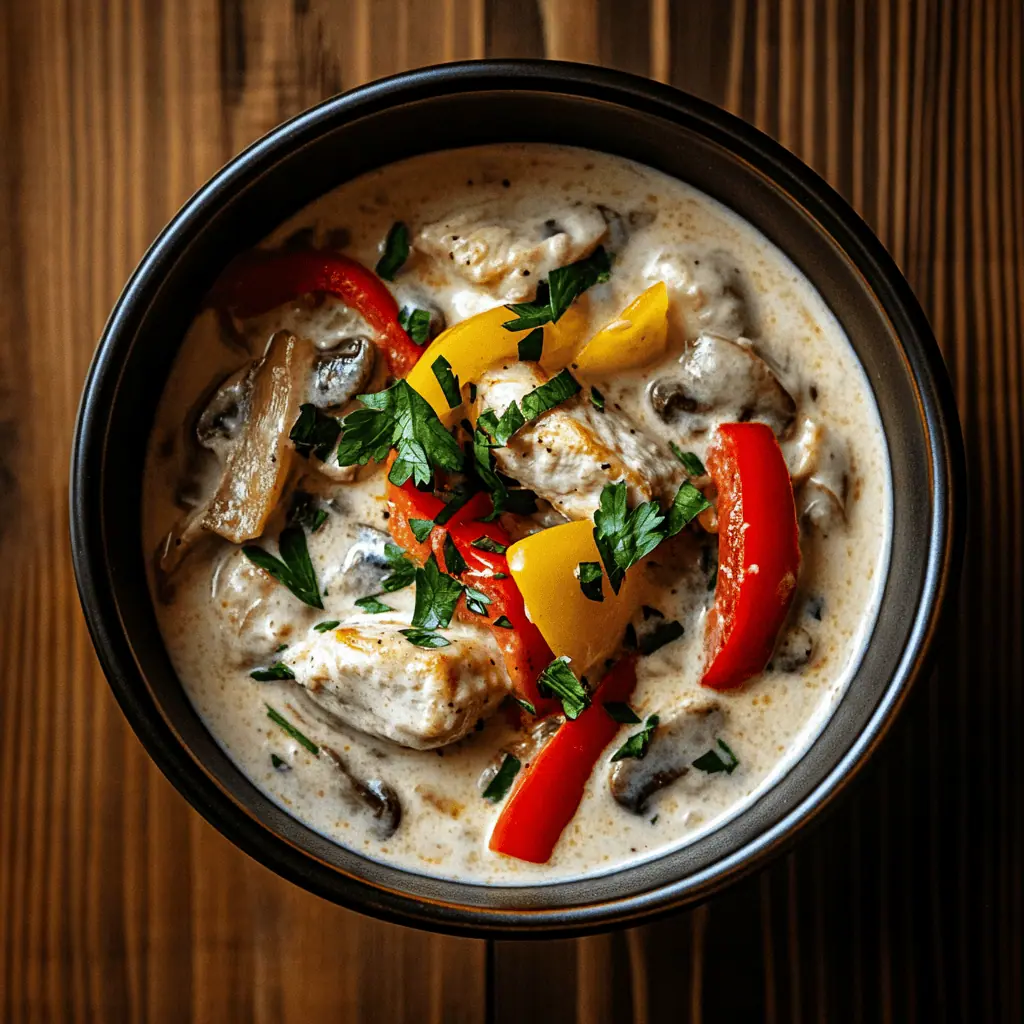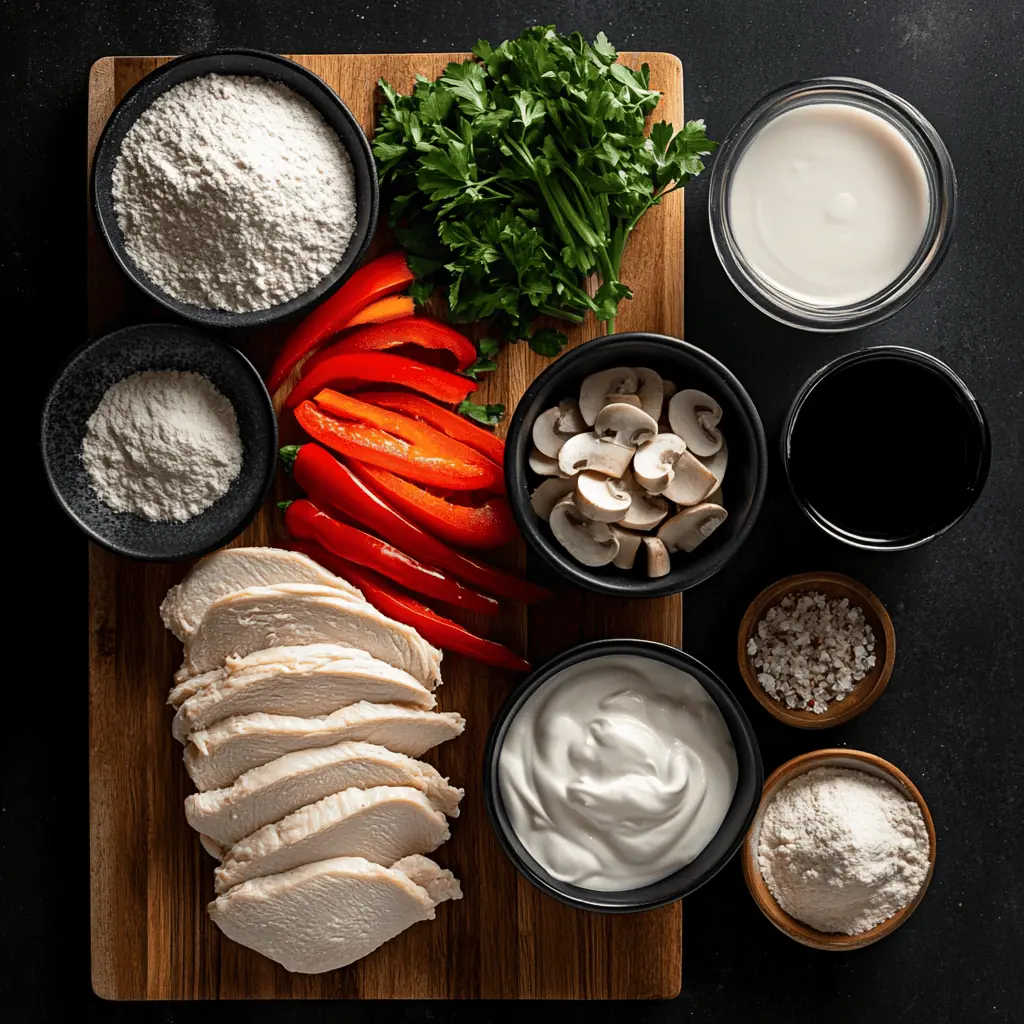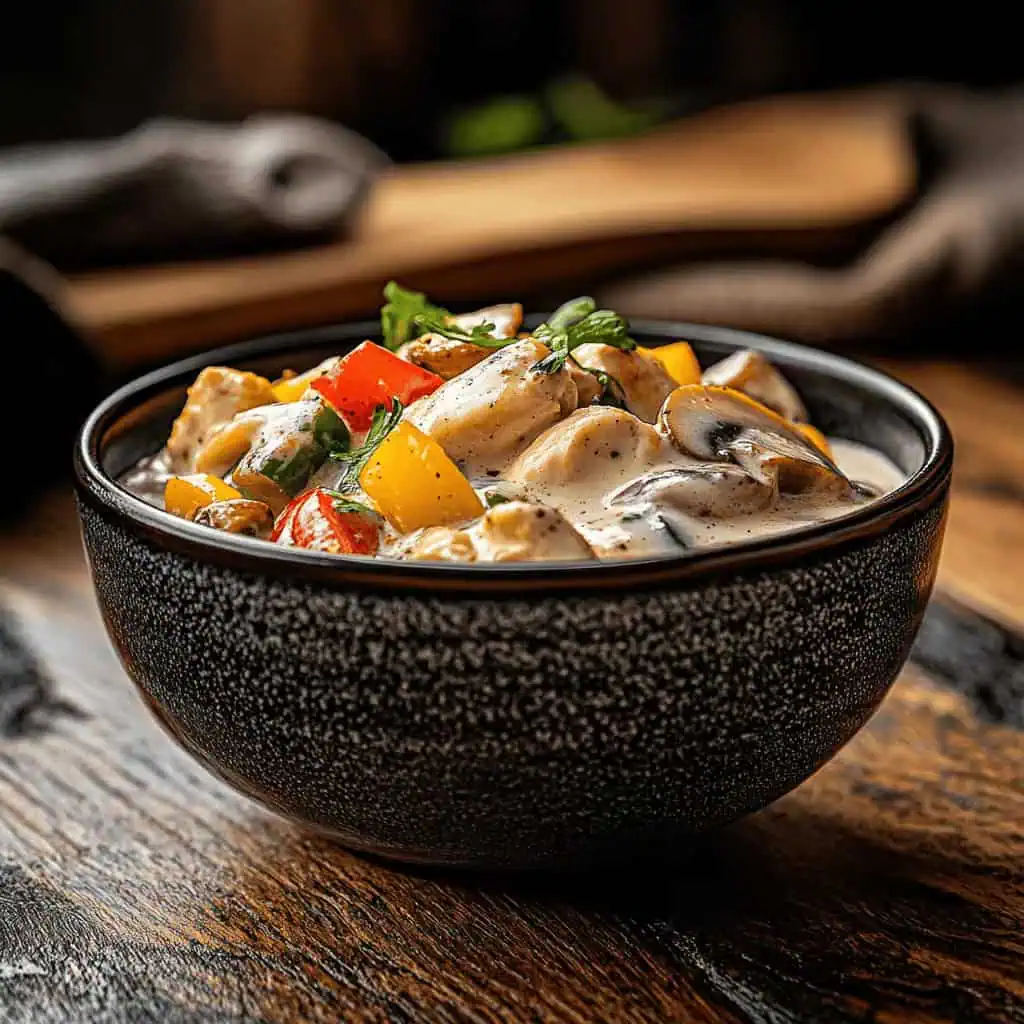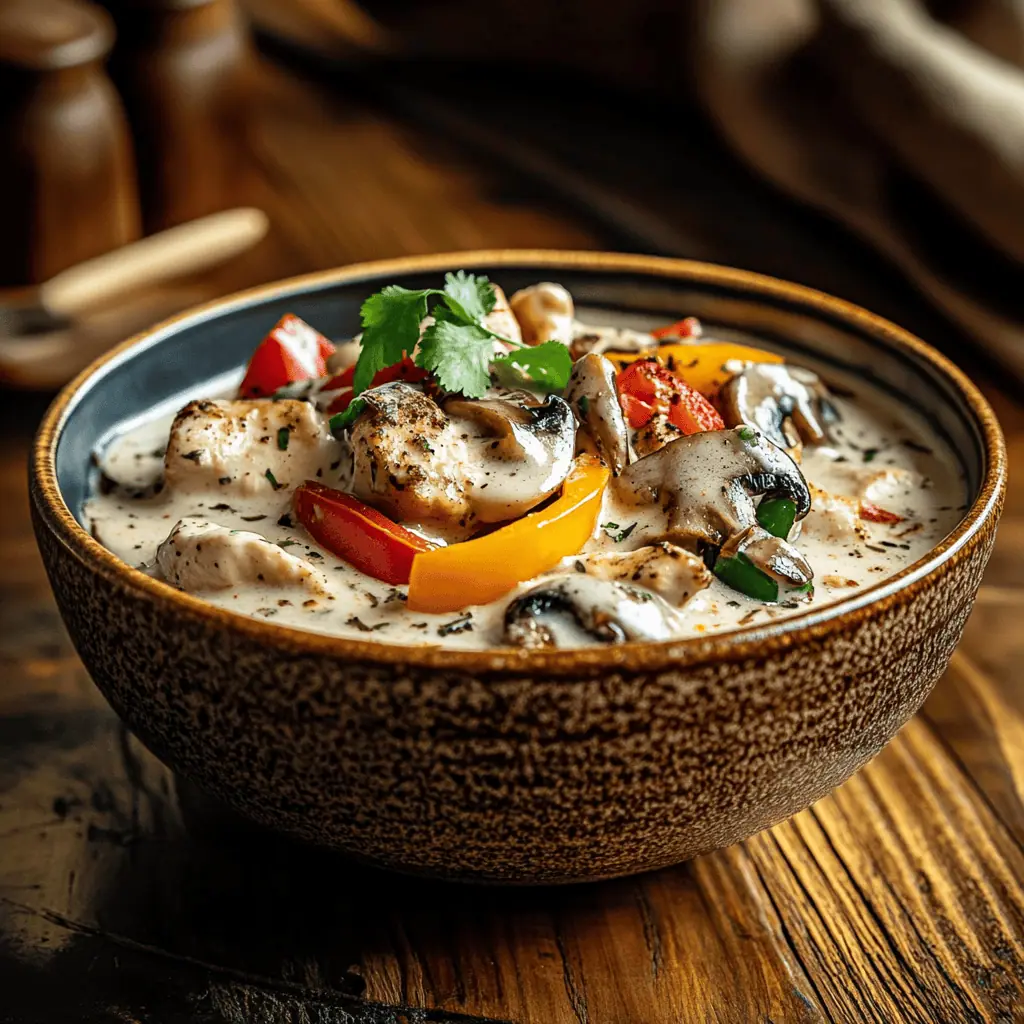I never thought I'd master making Chicken a la King at home, until my Lola shared her secrets for achieving that perfectly creamy sauce. This recipe takes me back to family gatherings, where we'd fight over who got the last scoop to pour over our steaming rice. After years of perfecting this recipe in my own kitchen, I've discovered that the magic lies in properly poaching the chicken (a technique I learned the hard way!) and slowly building that luxurious sauce that my kids now can't get enough of.
I'm excited to share my tried-and-tested version of this classic comfort food that combines the elegance of a restaurant-quality dish with the warmth of home cooking. While traditional recipes can be intimidating, I've broken it down into simple steps that even beginner cooks can follow.
Once you master this creamy chicken a la king recipe, it'll become your go-to dish for both special occasions and those times when you just want to make ordinary weeknight dinners feel extra special.
Jump to:

Why You'll Love This Recipe
- Restaurant-quality dish you can make at home
- Versatile - serve over rice, pasta, or bread
- Make-ahead friendly for busy weeknights
- Perfect for special occasions
- Uses simple, everyday ingredients
- Kid-friendly comfort food
Ingredients
This classic Filipino Chicken a la King combines ingredients that create perfect harmony in both flavor and texture. The chicken provides a tender, protein-rich base, while mushrooms add earthiness and meaty texture.
Bell peppers contribute vibrant color, slight sweetness, and gentle crunch. The sauce—built from butter, flour, broth, and cream: creates a silky foundation that binds everything together while adding luxurious richness. Sherry wine introduces subtle acidity that balances the cream's heaviness, while garlic and onions provide aromatic depth.
Bay leaves and peppercorns in the poaching liquid infuse the chicken with gentle flavor from within. Together, these ingredients create a balanced dish where each component enhances the others, resulting in a comforting yet sophisticated meal.

- 2 pounds chicken breasts
- 1 teaspoon salt
- ½ teaspoon whole peppercorns
- 3 cloves garlic, pounded
- 2 bay leaves
- ½ cup dry sherry wine
- 6 cups water
- 4 tablespoons butter
- 3 tablespoons all-purpose flour
- 1 onion, chopped
- 2 cloves garlic, minced
- ½ red bell pepper, chopped
- ½ green bell pepper, chopped
- 4 ounces fresh button mushrooms, sliced
- 2 cups reserved chicken broth
- 1 cup heavy cream
- Salt and pepper to taste
Equipment
- Large heavy-bottomed pot - Essential for properly poaching the chicken without scorching
- Sharp knife - For precisely cutting ingredients to ensure even cooking
- Cutting board - Provides a stable surface for safe food preparation
- Measuring cups and spoons - Ensures recipe accuracy for consistent results
- Whisk - Critical for creating a smooth, lump-free sauce
- Strainer - Used to separate and reserve the flavorful chicken broth
- Large skillet or sauté pan - Provides adequate surface area for sauce development
- Meat thermometer - Guarantees properly cooked chicken at the safe temperature of 165°F
- Kitchen scale - Enables precise measurements for professional-quality results

How To Make
- Begin by poaching the chicken. In a large pot, arrange chicken breasts in a single layer and add salt, peppercorns, pounded garlic, bay leaves, sherry wine, and water. The water temperature should be around 180°F/82°C - just below simmering. Bring to a gentle boil (205°F/96°C), then reduce heat to low, cover, and cook for 15 minutes or until internal temperature reaches 165°F/74°C.
- Remove chicken and let cool slightly before cutting into 1-inch cubes. Strain and reserve 2 cups of the broth for the sauce.
- For the sauce, melt butter in a large pan over medium heat (350°F/175°C). Sauté chopped onions and minced garlic until softened, about 3-4 minutes. Add chopped bell peppers and sliced mushrooms, cooking until tender, 5-6 minutes.
- Sprinkle flour over the vegetables and cook while stirring for 1-2 minutes. Gradually whisk in the reserved warm broth and heavy cream, stirring constantly to prevent lumps. Add the cubed chicken and simmer until the sauce thickens, 5-7 minutes. Season with salt and pepper to taste.
- Serve hot over steaming rice, toasted bread, or noodles. For best results, let the dish rest for 5 minutes before serving to allow the sauce to thicken further.

Tips from Lola's Kitchen
- Perfect Poaching: Never allow the poaching liquid to reach a full rolling boil—this is the secret to incredibly tender chicken that remains juicy.
- Silky Smooth Sauce: Always add warm (not cold) liquid to your roux and whisk continuously. This prevents lumps and creates that restaurant-quality velvety texture.
- Onion Preparation: Soak chopped onions in cold water for 10 minutes before cooking to remove bitterness and create a sweeter flavor profile.
- Vegetable Timing: Add bell peppers last among the vegetables to maintain their vibrant color and slight crispness.
- Proper Seasoning: Taste and adjust seasoning at the end of cooking—the flavors concentrate as the sauce reduces.
- Resting Period: Allow the finished dish to rest for 5 minutes before serving. This lets the sauce set to the perfect consistency and allows flavors to fully develop.
Substitutions
- Heavy cream: Use evaporated milk or coconut cream for a different flavor profile or lighter option.
- Fresh mushrooms: Canned mushrooms work in a pinch, though fresh provides better texture and flavor.
- Sherry wine: Substitute with white wine for a different flavor note or additional chicken broth for an alcohol-free version.
- Bell peppers: Swap with a combination of carrots and peas for a traditional variation.
- Button mushrooms: Try shiitake or oyster mushrooms for a more complex earthy flavor.
- Chicken breasts: Boneless thighs can be used for a more flavorful, richer dish.
Troubleshooting
- Sauce too thick: Add warm broth or cream one tablespoon at a time while whisking until desired consistency is reached.
- Sauce too thin: Continue simmering for a few additional minutes to reduce, or create a small amount of additional roux (butter and flour) in a separate pan, then gradually incorporate into the sauce.
- Curdled sauce: If your sauce begins to separate, immediately lower the heat and whisk vigorously until smooth. Adding a splash of cold cream can also help stabilize it.
- Dry chicken: This typically results from overcooking during the poaching stage. Ensure you maintain proper temperature and use a thermometer for accuracy.
- Bland flavor: Enhance with additional salt, a splash of sherry, or a squeeze of lemon juice to brighten all flavors.
Storage & Reheating
- Refrigeration: Store in an airtight container for up to 3 days. The flavors often deepen and improve overnight.
- Freezing: Can be frozen for up to 3 months, though the sauce may separate slightly upon thawing. Freeze in portion-sized containers for convenient reheating.
- Reheating: Always reheat on low heat, stirring frequently to prevent scorching or separation. Add a splash of cream or broth if the sauce has thickened too much during storage.
- Sauce Restoration: If the sauce breaks when reheating, transfer to a blender and pulse briefly, or whisk vigorously while adding a tablespoon of warm cream.

FAQ
Can I make this ahead of time?
Yes, you can prepare this dish up to 2 days ahead. Store in the refrigerator and reheat gently on the stovetop, adding a splash of cream if needed to restore the sauce's consistency.
Can I use rotisserie chicken instead of poaching my own?
Absolutely! Skip the poaching step and use approximately 4 cups of shredded rotisserie chicken. Add it during the final simmering stage.
Is this recipe freezer-friendly?
Yes, though cream-based sauces may separate slightly when thawed. Reheat slowly while whisking to recombine the sauce.
How can I make this recipe healthier?
Use milk or half-and-half instead of heavy cream, increase the amount of vegetables, and consider using skinless chicken breast.
Can I serve this for a large gathering?
This recipe scales beautifully. Double or triple ingredients as needed and consider keeping warm in a slow cooker on the lowest setting for buffet-style serving.
What's the best way to prevent curdling?
Keep heat low after adding cream and never allow the sauce to boil. Also, ensure your cream is at room temperature before adding to the hot mixture.
Can I add other vegetables?
Yes! Traditional additions include peas, carrots, or asparagus tips. Add them according to their cooking time requirements.
What wine pairs well with Chicken a la King?
A lightly oaked Chardonnay or Pinot Grigio complements the creamy sauce beautifully.
Related
Looking for other recipes like this? Try these:

Classic Filipino Chicken a la King (Creamy Chicken with Mushrooms and Peppers)
Equipment
- Large heavy-bottomed pot (kaldero) for poaching chicken
- Sharp knife (matulis na kutsilyo) for cutting ingredients
- Cutting board (tabla ng paghihiwaan)
- Measuring cups and spoons (Panukat)
- Whisk (wire whisk) for making smooth sauce
- Strainer [Salaan] for straining broth
- Large skillet or sauté pan for making the sauce
- Meat thermometer for checking chicken doneness
- Kitchen scale (timbangan) for precise measurements
Ingredients
For Poaching the Chicken:
- 2 pounds 1 kg chicken breasts (dibdib ng manok)
- 1 teaspoon salt asin
- ½ teaspoon whole peppercorns paminta
- 3 cloves garlic pounded
- 2 bay leaves dahon ng laurel
- ½ cup dry sherry wine
- 6 cups water tubig
For the Sauce:
- 4 tablespoons butter mantikilya
- 3 tablespoons all-purpose flour harina
- 1 onion chopped (sibuyas)
- 2 cloves garlic minced (dinurog na bawang)
- ½ red bell pepper chopped (pulang bell pepper)
- ½ green bell pepper chopped (berdeng bell pepper)
- 4 ounces fresh button mushrooms sliced (kabute)
- 2 cups reserved chicken broth sabaw ng manok
- 1 cup heavy cream krema
- Salt and pepper to taste asin at paminta
Instructions
- Begin by poaching the chicken. In a large pot (kaldero), arrange chicken breasts in a single layer and add salt (asin), peppercorns (paminta), pounded garlic, bay leaves (dahon ng laurel), sherry wine, and water (tubig). The water temperature should be around 180°F/82°C - just below simmering. Bring to a gentle boil (205°F/96°C), then reduce heat to low, cover, and cook for 15 minutes or until internal temperature reaches 165°F/74°C.
- Remove chicken and let cool slightly before cutting into 1-inch cubes. Strain and reserve 2 cups of the broth (sabaw ng manok) for the sauce.
- For the sauce, melt butter (mantikilya) in a large pan over medium heat (350°F/175°C). Sauté chopped onions (sibuyas) and minced garlic (dinurog na bawang) until softened, about 3-4 minutes. Add chopped bell peppers (bell pepper) and sliced mushrooms (kabute), cooking until tender, 5-6 minutes.
- Sprinkle flour (harina) over the vegetables and cook while stirring for 1-2 minutes. Gradually whisk in the reserved warm broth and heavy cream, stirring constantly to prevent lumps. Add the cubed chicken and simmer until the sauce thickens, 5-7 minutes. Season with salt and pepper (asin at paminta) to taste.
- Serve hot over steaming rice (kanin), toasted bread, or noodles (pancit). For best results, let the dish rest for 5 minutes before serving to allow the sauce to thicken further.
Tips from Lola's Kitchen
- Para hindi maging matamis ang sibuyas (To avoid bitter onions): Soak chopped onions in cold water for 10 minutes before cooking
- Para sa malutong na bell pepper (For crispy peppers): Add them last among the vegetables
- Para hindi magkaroon ng bulos ang sauce (For smooth sauce): Add warm liquid gradually while continuously whisking
- Para sa malambot na manok (For tender chicken): Never let the poaching liquid come to a rolling boil
Nutrition
The Story Behind Chicken a la King
As a home cook passionate about both Filipino cuisine and international dishes, I've always been fascinated by how Chicken a la King found its way into our local celebrations. This creamy chicken dish, known for its rich sauce and colorful vegetables, has an intriguing history that dates back to the late 1800s in New York City.
The most widely accepted story credits the creation to Chef George Greenwald at the Brighton Beach Hotel in New York, who first prepared it in the 1890s for hotel owner E. Clark King II and his wife. The dish was such a hit that it became known as "Chicken à la King." Other origin stories place its invention at Philadelphia's Bellevue Hotel or New York's Delmonico's Restaurant, but one thing's certain – this luxurious dish was born in upscale American hotel kitchens.
What makes this recipe particularly special to Filipino families like mine is how it transformed from an exclusive hotel menu item into a beloved party dish. During the American colonial period, Chicken a la King made its way to Philippine shores, where it was embraced and adapted to local tastes. Our version often features a slightly sweeter cream sauce and is typically served over rice instead of the traditional toast points or puff pastry – a perfect example of Filipino adaptation of Western cuisine.
In modern Filipino celebrations, you'll find this dish at children's birthday parties, Christmas gatherings, and even wedding receptions. It's become such a staple that many consider it part of Filipino comfort food repertoire, alongside sweet-style spaghetti and kaldereta. Local restaurants like Max's and Aristocrat have helped popularize it further, making it a must-have menu item for special occasions.
What I love most about making Chicken a la King at home is how it brings together the elegance of hotel cuisine with the warmth of Filipino home cooking. The combination of tender chicken chunks, mushrooms, and bell peppers in that signature creamy sauce creates a dish that's both nostalgic and sophisticated. Whether served over steaming white rice, topped on pandesal, or mixed with pancit, it's a versatile dish that continues to evolve while maintaining its status as a cherished family favorite.
The beauty of this recipe lies in its adaptability – every Filipino family has their own special twist. Some add quail eggs for extra richness, others incorporate carrots and peas for more color, while some families have secret ingredients passed down through generations. This flexibility, combined with its rich history, makes Chicken a la King not just a recipe, but a delicious testament to the wonderful fusion of international and Filipino cuisines.










Comments
No Comments